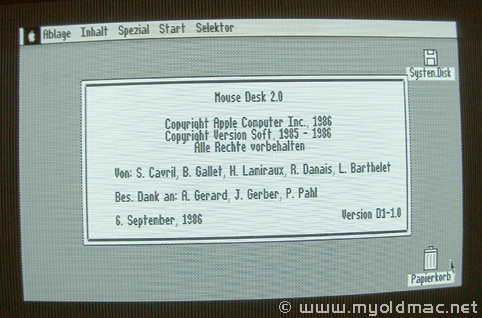|
Apple IIgs Computer
In Sep. 1986 Apple Computer introduces the Apple
IIgs, with the Apple 3.5 drive, for $1000 US.
The last member of the Apple II line, The Apple
IIgs was also the most powerful. It included expanded
graphics and sound functions, and was initially
offered with 256k of RAM, expandable to 8 MB.
The IIgs also offered 128k of ROM, expandable
to 1 MB.
|
The IIgs shipped with a Mac-like interface
and introduced the Apple Desktop Bus (ADB) port.
(It also ran most other Apple II software.). In
Sep. 1988 Apple Computer releases GS/OS, a 16-bit
operating system for the Apple IIgs. The IIgs
was later offered with 1 MB of RAM, and 256k of
ROM. It could also hold a SCSI adapter card. In
Dec. 1992 Apple Computer discontinues the Apple
IIgs.
Steve Wozniak was quite involved in designing the general
layout of the IIGS. Insisting on keeping it simple,
he recommended against a built-in co-processor
(as they tried to do with the IIx). He also wanted
to keep the 8-bit part of the machine separate
from the 16-bit part. To accomplish this, he and
the other engineers decided to design it so the
memory in the lower 128K of the machine was "slow
RAM", which made it possible for it to function
just as it did on the older Apple II's. This included
the memory allocation for the odd addressing schemes
used in the text and graphics modes and (which
made sense in 1976, but not in 1986). The rest
of the available memory space would be fast, and
could be expanded to as much as 16 megabytes.
With a faster microprocessor, it would also be
possible to run programs more quickly than on
the older Apple II's. Info Source: Duprau,
Jeanne, and Tyson, Molly. "The Making Of
The Apple IIGS", A+ Magazine, Nov 1986: 57-74.
Sales were strong initially and the IIGS even
outsold the black and white Macintosh units that
were its contemporary. Sadly, Apple wanted Macintosh
to be its future. The total number of advertisements
and commercials for the IIGS could probably be
counted on one hand. If the computer had been
introduced a year or two earlier, things might
have been different. The last member of the Apple
II line, was the most powerful Apple. The IIgs
was built around a Western Design Center 65C816
processor running at either 2.8 or 1 Mhz. It included
expanded graphics and sound functions, and was
initially offered with 256k of RAM, expandable
to 8 MB. The IIgs also offered 128k of ROM, expandable
to 1 MB. The IIgs shipped with a Mac-like interface
and a IIgs-specific OS, and introduced the Apple
Desktop Bus (ADB) port. (It also ran most other
Apple II software.) The IIgs was later offered
with 1 MB of RAM, and 256k of ROM. It could also
hold a SCSI adapter card. It was discontinued
in December of 1992.
The Ensoniq chip in the Apple IIGS was a brilliant
move by Apple, but it drew a lawsuit from Apple
Records, the Beatles' record label. Apple never
again put a synthesizer chip in any computer.
Even today, the Macintosh does not have hardware
synthesizers. The Macintosh works around this
by using software-based synthesis.
Apple II GS
Easter Egg: The IIGS with ROM version 3 has an
audio recording built-in. Upon booting, when you
see the "Open Apple" move back and forth
on the screen, press <Control> <Open
Apple> <Option> <N>. You will hear
the IIGS design team shouting "Apple 2". Apple
Museum has an actual sound sample on their Apple
][ GS page that you can listen to. On older
sytems with ROM version 1, you will see developers
credits.
Find Apple IIgs Software - today! = http://modena.intergate.ca
Photos

The original Apple IIgs MouseDesk System
|

![]()